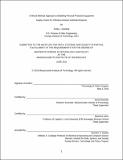| dc.contributor.advisor | Jarrod Goentzel and Marianne Jahre. | en_US |
| dc.contributor.author | Gooding, Emily J. (Emily Joanne) | en_US |
| dc.contributor.other | Technology and Policy Program. | en_US |
| dc.date.accessioned | 2016-10-14T14:41:26Z | |
| dc.date.available | 2016-10-14T14:41:26Z | |
| dc.date.copyright | 2016 | en_US |
| dc.date.issued | 2016 | en_US |
| dc.identifier.uri | http://hdl.handle.net/1721.1/104810 | |
| dc.description | Thesis: S.M. in Technology and Policy, Massachusetts Institute of Technology, School of Engineering, Institute for Data, Systems, and Society, Technology and Policy Program, 2016. | en_US |
| dc.description | This electronic version was submitted by the student author. The certified thesis is available in the Institute Archives and Special Collections. | en_US |
| dc.description | Cataloged from student-submitted PDF version of thesis. | en_US |
| dc.description | Includes bibliographical references (pages 115-121). | en_US |
| dc.description.abstract | Personal protective equipment (PPE) is critical to the protection of healthcare workers responding to infectious disease outbreaks. The ability of the PPE supply chain to provide adequate and consistent supply when there is a large spike in demand has not been well-considered. Humanitarian logistics literature rarely considers infectious disease outbreaks as possible humanitarian crises while epidemiology literature assumes perfectly responsive supply chains. This thesis uses a mixed methods approach - an exploratory case study and system dynamics model - to bridge the gap between these two fields. It provides one approach for connecting epidemiology and supply chain research. An explanatory case study of the 2014 West Africa Ebola outbreak is used to analyze the PPE supply chain and its in-crisis functionality. We gather primary data using semi-structured interviews with supply chain actors and analyze that data using qualitative coding analysis. The system dynamics model is developed based on the results of the case study to offer insight as to how the PPE supply chain could be improved to better respond to future outbreaks. Several scenarios are simulated to test the effects of various supply chain improvement strategies. Relationship-building between supply chain actors, unconstrained shipping channels, flexible funding pools, and pre-positioning are all found to be effective supply chain improvement strategies. | en_US |
| dc.description.statementofresponsibility | by Emily J. Gooding. | en_US |
| dc.format.extent | 121 pages | en_US |
| dc.language.iso | eng | en_US |
| dc.publisher | Massachusetts Institute of Technology | en_US |
| dc.rights | M.I.T. theses are protected by copyright. They may be viewed from this source for any purpose, but reproduction or distribution in any format is prohibited without written permission. See provided URL for inquiries about permission. | en_US |
| dc.rights.uri | http://dspace.mit.edu/handle/1721.1/7582 | en_US |
| dc.subject | Institute for Data, Systems, and Society. | en_US |
| dc.subject | Engineering Systems Division. | en_US |
| dc.subject | Technology and Policy Program. | en_US |
| dc.title | A mixed methods approach to modeling personal protective equipment supply chains for infectious disease outbreak response | en_US |
| dc.type | Thesis | en_US |
| dc.description.degree | S.M. in Technology and Policy | en_US |
| dc.contributor.department | Massachusetts Institute of Technology. Engineering Systems Division | |
| dc.contributor.department | Massachusetts Institute of Technology. Institute for Data, Systems, and Society | |
| dc.contributor.department | Technology and Policy Program | |
| dc.identifier.oclc | 958277973 | en_US |
